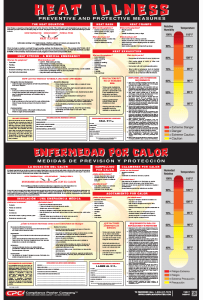 The first triple digit temperatures of the year have already hit California. With summer just around the corner, Cal/OSHA is urging employers to review their heat illness prevention plans and emergency response procedures to make sure their workers are prepared and protected from increasing outdoor temperatures and the risk of heat-related illness.
The first triple digit temperatures of the year have already hit California. With summer just around the corner, Cal/OSHA is urging employers to review their heat illness prevention plans and emergency response procedures to make sure their workers are prepared and protected from increasing outdoor temperatures and the risk of heat-related illness.
Outdoor Places of Employment
This time of year, the risk of heat illness is generally highest for people who work outdoors. Therefore, Cal/OSHA requires employers to have an effective written heat illness prevention plan for all outdoor places of employment. Cal/OSHA focuses its enforcement inspections on outdoor worksites in industries such as agriculture, landscaping and construction. However, “outdoor places of employment” is broadly interpreted and includes open areas like agricultural fields, forests, parks, equipment and storage yards, outdoor utility installations, tarmacs, roads, outdoor construction sites, loading docks and partial structures that do not provide sufficient protection from the heat.
High-risk Industries
In addition, employers in certain industries must take additional steps to monitor workers for signs and symptoms of heat illness whenever temperatures reach or exceed 95 degrees. The additional high heat requirements apply to:
- Agriculture,
- Construction,
- Landscaping,
- Oil and gas extraction, and
- Transportation and delivery of agricultural products and heavy materials.
Cal/OSHA Heat Illness Standard
California’s heat illness regulations require employers to take the following steps to prevent heat illness:
- Training – Train all employees and supervisors on heat illness prevention in the languages workers understand prior to starting work.
- Water – Provide enough fresh, pure, suitably cool drinking water so that each worker can drink at least 1 quart per hour and encourage them to do so.
- Shade – Provide access to a shaded area upon request or whenever the temperature exceeds 80 degrees, and encourage short cool-down rests in shaded areas. Workers should not wait until they feel sick to cool down.
- Monitoring – Closely observe employees during heat waves, allow workers to acclimatize to the heat, provide cool-down rest breaks, and implement emergency response procedures when necessary.
- Plan – Develop and implement a written Heat Illness Prevention Plan.
The most frequent violation that Cal/OSHA cites during targeted heat inspections is for failure to have a proper written heat illness prevention plan specific to the worksite. Serious violations are often related to inadequate access to water and shade and lack of supervisor and employee training.
Federal Law
Federal OSHA does not have specific heat illness regulations. However, under Federal OSHA law employers are responsible for providing workplaces free of known safety hazards. This includes protecting workers from extreme heat. Therefore, employers everywhere should be prepared for extreme outdoor temperatures. Federal OSHA recommends following the same prevention steps outlined in California’s regulations.
Support your training program using these tools:

